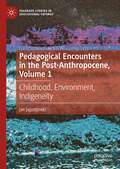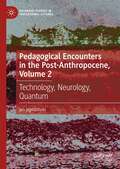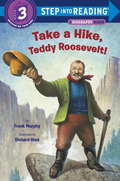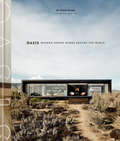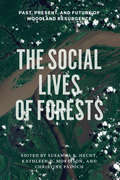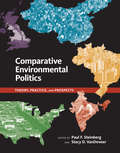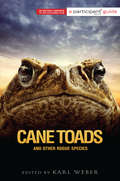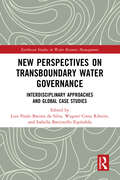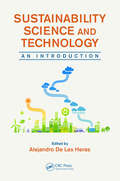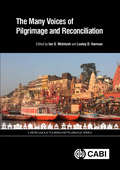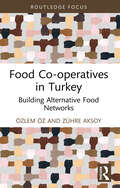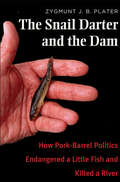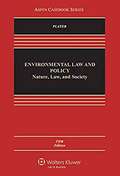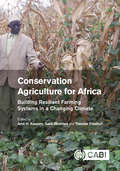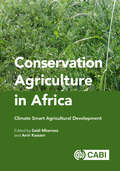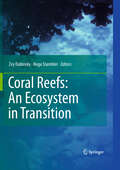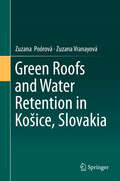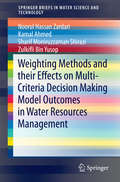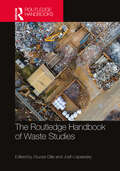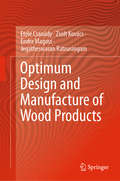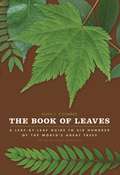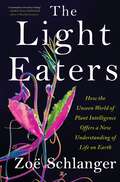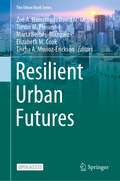- Table View
- List View
Pedagogical Encounters in the Post-Anthropocene, Volume 1: Childhood, Environment, Indigeneity (Palgrave Studies in Educational Futures)
by jan jagodzinskiThis volume, the first of a two volume set, addresses three major areas in response to the post-Anthropocene: childhood, environment and indigeneity. Each of these areas is broadly addressed in relation to the concerns that have arisen both theoretically and educationally. The author terms these to be encounters as each area presents a particular problematic when addressing the phase change that the planet is undergoing where the anthropogenic labour of global humanity is contributing to climate change, endangering our very existence. There has been a concerted effort to overcome the nature-culture divide in education. The author reviews this development in the first section where there has been a particular emphasis placed on childhood education. In the second section he turns to the pedagogical theories that are attempting to overcome this same divide in environmental and science education. The last section attempts to bring into the conversation the vast literature on Indigeneity and their attempts to revise traditional education to meet these extraordinary times.
Pedagogical Encounters in the Post-Anthropocene, Volume 2: Technology, Neurology, Quantum (Palgrave Studies in Educational Futures)
by jan jagodzinskiAs a follow up to Pedagogical Encounters in the Post-Anthropocene, Volume I, this book addresses three major areas in response to the post-Anthropocene: Technology, Neurology, Quantum. Each of these areas is broadly addressed in relation to the concerns that have arisen both theoretically and educationally. As in Volume I, the author terms these to be encounters as each area presents a particular problematic when addressing the phase change that the planet is undergoing where the anthropogenic labour of global humanity is contributing to climate change, endangering our very existence. Technology in education has been a significant development. There is a concerted effort to review this development placing stress on the rise of learning machines and algorithms. In the second encounter the vast literature on neurology is addressed, especially neurodiversity and the various symptoms that have emerged in the post-Anthropocene era. The last section reviews issues related to quantum theory as this is fundamental to tensions between physics and metaphysics. The volume concludes with the author’s own pedagogical proposal for the future.
Take a Hike, Teddy Roosevelt! (Step into Reading)
by Frank Murphy illustrated by Richard WalzA Step 3 Step into Reading Biography Reader about Teddy Roosevelt and his efforts to protect our environment and establish national parks. Teddy battled asthma all his life, and the list of things he shouldn't do was long. But when people told him "you can't," he set about proving them wrong. This book focuses on his inexhaustible enthusiasm and his commitment to preserving America's natural resources. Step 3 Readers feature engaging characters in easy-to-follow plots about popular topics. For children who are ready to read on their own.
Oasis: Modern Desert Homes Around the World
by iO Tillett WrightWelcome to the desert. Welcome home. This visually stunning tour of the world's most amazing desert homes will inspire &“desert vibes&” wherever you are. Creatives are drawn in by the extreme landscapes and limited resources of the desert; in fact, they&’re inspired by them, and the homes they&’ve built here prove it. From renovated Airstreams to sprawling, modern stucco, desert has become the new beachfront.In Oasis, artist iO Tillett Wright captures the best of this specific culture that emphasizes living simply, beautifully, and in connection with the earth. He highlights the homes that define this desert mindset, featuring the classics like Georgia O'Keefe's in Abiquiu, New Mexico, alongside more modern homes such as Michael Barnard&’s Solar House in Marfa, Texas. Casey Dunn&’s stunning photography will transport you to these relaxing refuges where you'll learn what elements create the balance of intentionality, ease, style, and function that these homes exude.
Climate Change and Agriculture in Africa: Impact Assessment and Adaptation Strategies (Earthscan Climate)
by Ariel Dinar Robert Mendelsohn Rashid Hassan James Benhin et al'This is a well researched, thorough and impressive work on climate change and agriculture in Africa. I recommend it to students, researchers and practitioners working on climate change issues' Jabavu Clifford Nkomo, senior programme specialist, IDRC This landmark book encompasses a comprehensive assessment of the potential economic impacts of future climate change, and the value of adaptation measures in Africa for different zones, regions, countries and farm types. Researchers developed and applied multiple analytical procedures to assess quantitatively how climate affects current agricultural systems in Africa, enabling them to predict how these systems may be affected in the future by climate change under various global warming scenarios, and suggesting what role adaptation could play. The study is the first to combine spatially referenced household survey data with climatic data at both national and international levels. This book provides vital knowledge about the impacts of climate change on Africa, serving as a guide to policy intervention strategies and investment in adaptation measures. It makes a major contribution to the analysis of climate change impacts and developing adaptation strategies, especially in the highly vulnerable farming communities in the developing world. Published with CEEPA and supported by the World Bank.
The Social Lives of Forests: Past, Present, and Future of Woodland Resurgence
by Christine Padoch edited by Susanna B. Hecht Kathleen D. MorrisonForests are in decline, and the threats these outposts of nature face--including deforestation, degradation, and fragmentation--are the result of human culture. Or are they? This volume calls these assumptions into question, revealing forests' past, present, and future conditions to be the joint products of a host of natural and cultural forces. Moreover, in many cases the coalescence of these forces--from local ecologies to competing knowledge systems--has masked a significant contemporary trend of woodland resurgence, even in the forests of the tropics. Focusing on the history and current use of woodlands from India to the Amazon, The Social Lives of Forests attempts to build a coherent view of forests sited at the nexus of nature, culture, and development. With chapters covering the effects of human activities on succession patterns in now-protected Costa Rican forests; the intersection of gender and knowledge in African shea nut tree markets; and even the unexpectedly rich urban woodlands of Chicago, this book explores forests as places of significant human action, with complex institutions, ecologies, and economies that have transformed these landscapes in the past and continue to shape them today. From rain forests to timber farms, the face of forests--how we define, understand, and maintain them--is changing.
Comparative Environmental Politics: Theory, Practice, and Prospects (American and Comparative Environmental Policy)
by Stacy D. VanDeveer edited by Paul F. SteinbergCombining the theoretical tools of comparative politics with the substantive concerns of environmental policy, experts explore responses to environmental problems across nations and political systemsHow do different societies respond politically to environmental problems around the globe? Answering this question requires systematic, cross-national comparisons of political institutions, regulatory styles, and state-society relations. The field of comparative environmental politics approaches this task by bringing the theoretical tools of comparative politics to bear on the substantive concerns of environmental policy. This book outlines a comparative environmental politics framework and applies it to concrete, real-world problems of politics and environmental management.After a comprehensive review of the literature exploring domestic environmental politics around the world, the book provides a sample of major currents within the field, showing how environmental politics intersects with such topics as the greening of the state, the rise of social movements and green parties, European Union expansion, corporate social responsibility, federalism, political instability, management of local commons, and policymaking under democratic and authoritarian regimes. It offers fresh insights into environmental problems ranging from climate change to water scarcity and the disappearance of tropical forests, and it examines actions by state and nonstate actors at levels from the local to the continental. The book will help scholars and policymakers make sense of how environmental issues and politics are connected around the globe, and is ideal for use in upper-level undergraduateand graduate courses.
Cane Toads and Other Rogue Species: Participant Second Book Project
by Participant Productions edited by Karl WeberWhat does an unusually large, ugly, invasive species of toad have to do with global warming, international trade, and the survival of biodiversity? Quite a lot, actually. Mark Lewis's amazing and hilarious documentary Cane Toads tells the story of Bufo marinus, which was introduced to Australia in 1935 to control bugs but which quickly became a far greater menace than the beetles they eat. Today they number in the hundreds of millions and are taking over Australian habitats at 25 miles per year, spreading disease and killing native species as they go. Rogue Species explains the little-understood dangers of invasive species. Ranging from the zebra mussel (currently threatening the health of the Great Lakes) to the infamous kudzu vine (a Japanese import that now smothers seven million acres in the American southeast), these disastrous human blunders threaten the biodiversity on which all life-including our own-depends. The book will raise readers' awareness about the threat of non-native species, increase their appreciation of natural biodiversity, and explain what they can do to help protect unique ecosystems wherever they live or travel.
New Perspectives on Transboundary Water Governance: Interdisciplinary Approaches and Global Case Studies (Earthscan Studies in Water Resource Management)
by Wagner Costa Ribeiro da Silva, Luis Paulo Batista Isabela Battistello EspíndolaThis book presents a novel examination of transboundary water governance, drawing on global case studies and applying new theoretical approaches. Excessive consumption and degradation of natural resources can either heighten the risks of conflicts or encourage cooperation within and among countries, and this is particularly pertinent to the governance of water. This book fills a lacuna by providing an interdisciplinary examination of transboundary water governance, presenting a range of novel and emerging theoretical approaches. Acknowledging that issues vary across different regions, the book provides a global view from South and Central America, Africa, Asia, and the Middle East, with the case studies offering civil society and public managers concrete situations that indicate difficulties and successes in water sharing between bordering countries. The volume highlights the links between natural resources, political geography, international politics, and development, with chapters delving into the role of paradiplomacy, the challenges of climate change adaptation, and the interconnections between aquifers and international development. With rising demand for water in the face of climate change, this book aims to stimulate further theoretical, conceptual, and methodological debate in the field of transboundary water governance to ensure peaceful and fair access to shared water resources. This book will be of interest to students and scholars of water resource governance from a wide variety of disciplines, including geography, international relations, global development, and law. It will also be of interest to professionals and policymakers working on natural resource governance and international cooperation.
Sustainability Science and Technology: An Introduction
by alejandro de las herasSustainability Science and Technology: An Introduction explains the root causes of global failures in natural and human systems, as well as the most readily available technological solutions. The book dispels risky scientific and technological ideas that further complicate the current environmental and socioeconomic predicaments. It also bridges ga
Many Voices of Pilgrimage and Reconciliation, The (CABI Religious Tourism and Pilgrimage Series)
by Lucinda Carspecken E. Moore Quinn Tahar Abbou John Hornblow Jenny Boyack Sonika Jain Nanna Natalia Jørgensen Steven Muir Zülfükar Özdogan Cindy Pavlinac Mari-Johanna Rahkala-Simberg Varada Sambus Patricia A. Sayre Daniel J. Simons Chadwick Co Su Sara TerreaultReviewing peace and reconciliation, secular pilgrimages, and international perspectives on sacred journeys, this book offers the reader an opportunity to encounter multiple voices and viewpoints on one of the most ancient practices of humankind. With an estimated third of all international travellers now undertaking journeys anticipating an aspect of transformation (the hallmark of pilgrimage), this book includes both spiritual and non-spiritual voyages, such as journeys of self-therapy, mindfulness and personal growth. It also: - Provides a multidisciplinary perspective, covering themes such as gender, human rights, equality, the environment, peace, history, literature, and politics - Reflects the rich diversity and multiple meanings of pilgrimage through an international writer team spanning four continents - Includes case studies of pilgrimage in action from around the world An innovative and engaging addition to the pilgrimage literature, this book provides an important resource for researchers of religious tourism and related subjects.
Food Co-operatives in Turkey: Building Alternative Food Networks (Routledge Focus on Environment and Sustainability)
by Özlem Öz Zühre AksoyThis book addresses the roles played by food co-operatives in the attempt to build alternative food networks, drawing on an in-depth analysis of case studies in Turkey. While many existing studies focus on food co-operatives and alternative food networks in the Global North, this book provides an important insight into a country from the Global South and, in doing so, not only provides a novel perspective but also challenges the rigid North–South categorization. The book provides a rounded view by examining both a producer and a consumer co-operative: BÜKOOP is a university-based consumer food co-operative, and the Vakıflı co-operative is a food-producing co-operative located in the Hatay province on the Mediterranean coast of Turkey. These two co-operatives, which have been working together for more than ten years, share the dream of establishing a network of co-operatives, in which producers exist in solidarity with consumers, blurring the dichotomy of producer versus consumer as well as rural versus urban. In addition to contributing towards a better understanding of the urban–rural divide, within the framework of alternative food networks, the in-depth analysis of these two cases enables us to explore how food co-operatives develop and how they keep their commitment to their original goals and ideals so as to help build an alternative food system. The lessons we learn from these two working case examples highlight the successes and areas of improvement for food co-operatives. They also provide evidence against the pessimism about alternative food networks by demonstrating that co-operatives can democratize both production and consumption. This book will be of interest to students and scholars studying alternative food networks, food justice, food sovereignty, transformation towards sustainable food systems, social movements, and the urban–rural divide.
The Snail Darter and the Dam
by Zygmunt Jan PlaterEven today, thirty years after the legal battles to save the endangered snail darter, the little fish that blocked completion of a TVA dam is still invoked as an icon of leftist extremism and governmental foolishness. In this eye-opening book, the lawyer who with his students fought and won the Supreme Court case--known officially as Tennessee Valley Authority v. Hill--tells the hidden story behind one of the nation's most significant environmental law battles.The realities of the darter's case, Plater asserts, have been consistently mischaracterized in politics and the media. This book offers a detailed account of the six-year crusade against a pork-barrel project that made no economic sense and was flawed from the start. In reality TVA's project was designed for recreation and real estate development. And at the heart of the little group fighting the project in the courts and Congress were family farmers trying to save their homes and farms, most of which were to be resold in a corporate land development scheme. Plater's gripping tale of citizens navigating the tangled corridors of national power stimulates important questions about our nation's governance, and at last sets the snail darter's record straight.
Environmental Law and Policy: Nature, Law, and Society (Aspen Casebook)
by Lisa Heinzerling Zygmunt J. B. Plater Robert H. Abrams Robert L. Graham David A. Wirth Noah D. HallEnvironmental Law & Policy: Nature, Law & Society is a coursebook designed to access the law of environmental protection through a “taxonomic” approach, exploring the range of legal structures and legal methodologies of the field—rather than simply designing it according to air, water, toxics, etc. as subject media (which often results in duplicative legal coverage). All the major subject areas of pollution and resource conservation are covered, but they are covered according to the legal approaches they represent. <p><p> The book is “Saxist,” because it originally arose and continues to carry on themes from the teaching, guidance, and writings of the late Joseph Sax, the eminent pioneer of the environment law field who emphasized the interaction between common law and public law statutory structures, and introduced the public trust doctrine as a thread undergirding and running through the entire field of environmental law.
Conservation Agriculture for Africa: Building Resilient Farming Systems in a Changing Climate
by Dennis Dennis Peter Dorward Michael Misiko John A. Pickett J N Blignaut H Boulal Roland Bunch Trent W Bunderson Oussama El Gharras Mohammed El Mourid Mphatso Gama Zwide D Jere Josef Kienzle Jaap Knot Erna Kruger Peter Kuria Baqir Lalani Simon Lugandu Brand Mbale Charles Midega Zeyaur Khan Obedi Mkandawire Alice Murage Richard M. Museka Weldone Mutai Blessings M. Mwale Spencer W.D. Ng’oma John M. Paul Jimmy Pittchar Brian G. Sims Hendrik J. Smith Phillip Tembo Christian Thierfelder Patrick C. Wall Reynolds K. Shula Jose DambiroTillage agriculture has led to widespread soil and ecosystem degradation. This book reviews research and development initiatives in Africa aimed at building resilient farming systems. It summarises the status of conservation agriculture today, discusses prospects for future development and provides case studies showing its performance in Africa.
Conservation Agriculture in Africa: Climate Smart Agricultural Development
by Neil Miller Richard Bell Patrick Gicheru Trent W Bunderson Zwide D Jere Josef Kienzle Erna Kruger Peter Kuria Simon Lugandu Weldone Mutai Brian G. Sims Hendrik J. Smith Christian Thierfelder Reynolds K. Shula Johann Strauss Joseph Mureithi Mohamed Annabi Haithem Bahri Mloza Banda Gotlieb Basch Alexandra Bot Martin Bwalya Hatem Cheikh M’hamed Cornelius Chiduza Cary Clark Demba Diakhaté Mazwi Dlamini Sjoerd Duiker Alioune Fall Aymen Frija Josiah Gitari Tom Goddard Emilio Gonzalez-Sanchez Isaac Gura Enamul Haque Michel Havard Zied Idoudi Mohammad Jahiruddin Onesmos Kitonyo Phlorentin Philip Lagwen Ngari Macharia Temakholo Mathebula Sixolise Mcinga Alfred Micheni Frank Mmbando Rachid Moussadek Pearson Nyari Mnkeni Rachid Mrabet Ndabhemeye Mulengera Walter Mupangwa R. M. Museka Munyaradzi Mutenje Lindah Muzangwa Remmy Mwakimbwala Andre A Nel James Njeru Rama Ngatoluwa Phumzile Ngcobo Isaiah Nyagumbo Putso Nyathi Ricardo Ralisch Leonard Rusinamhodzi John Sariah Ibrahima Sarr Peter Setimela Richard Shetto Dimas Soares Júnior Peter Steward Gerhardus Trytsman Jean Twilingiyumukiza Carl Wahl Peter Waweru Nouhoun ZampaligreTillage agriculture has led to widespread soil and ecosystem degradation globally, and more particularly in the developing regions. This is especially so in Africa where traditional agricultural practices have become unsustainable due to severe exploitation of natural resources with negative impacts on the environment and food system. In addition, agricultural land use in Africa today faces major challenges including increased costs, climate change and a need to transform to more sustainable production intensification systems. Conservation Agriculture has emerged as a major alternative sustainable climate smart agriculture approach in Africa and has spread to many African countries in the past decade as more development and research, including in sustainable mechanization, has enabled its extension and uptake. It is key to transforming Africa's agriculture and food system given its ability to restore soil health, biodiversity and productivity of millions of smallholder farms as well as larger-scale farms. This landmark volume is based on the material presented at the Second Africa Congress on Conservation Agriculture which was held in Johannesburg, South Africa, 9-12 October 2018. The main theme of the Congress was 'Making Climate Smart Agriculture Real in Africa with Conservation Agriculture: Supporting the Malabo Declaration and Agenda 2063'. The Congress was aligned to mobilize stakeholders in all agriculture sectors to provide greater technical, institutional, development and investment support, impetus and direction to the vision and agenda for transforming African agriculture as set out by the Malabo Declaration and Agenda 2063. This book is aimed at all agricultural stakeholders in the public, private and civil sectors in Africa engaged in supporting the transformation of conventional tillage agriculture to Conservation Agriculture. The book will be of interest to: researchers, academics, students, development stakeholders, public and private sector investors and policy makers as well as institutional libraries across the world.
Coral Reefs: An Ecosystem In Transition
by Zvy Dubinsky Noga StamblerThis book covers in one volume materials scattered in hundreds of research articles, in most cases focusing on specialized aspects of coral biology. In addition to the latest developments in coral evolution and physiology, it presents chapters devoted to novel frontiers in coral reef research. These include the molecular biology of corals and their symbiotic algae, remote sensing of reef systems, ecology of coral disease spread, effects of various scenarios of global climate change, ocean acidification effects of increasing CO2 levels on coral calcification, and damaged coral reef remediation. Beyond extensive coverage of the above aspects, key issues regarding the coral organism and the reef ecosystem such as calcification, reproduction, modeling, algae, reef invertebrates, competition and fish are re-evaluated in the light of new research and emerging insights. In all chapters novel theories as well as challenges to established paradigms are introduced, evaluated and discussed. This volume is indispensible for all those involved in coral reef management and conservation.
Green Roofs and Water Retention in Košice, Slovakia
by Zuzana Poórová Zuzana VranayováThis book discusses how climate change and heat islands are a main contributor to water related problems in urban areas in Košice, Slovakia. Green roofs are used as a tool to assist in solving these water related issues. The need to provide housing in urban areas is expected to rise to 66% in 2050, according to the United Nations. Many urban areas have seen natural permeable green areas replaced with concrete constructions and hard, non-permeable surfaces. The densification of existing built-up areas is responsible for the decreasing vegetation, which results in the lack of evapotranspiration cooling the air, thereby creating urban heat islands. Several studies, discussed in this book, have shown that natural and permeable surfaces, as in the case of green roofs, can play a crucial role in mitigating this negative climate phenomenon and providing higher efficiency for buildings, leading to savings such as water, one of the focal points of this research.
Weighting Methods and their Effects on Multi-Criteria Decision Making Model Outcomes in Water Resources Management
by Noorul Hassan Zardari Kamal Ahmed Sharif Moniruzzaman Shirazi Zulkifli Bin YusopThis book provides a systematic way of how to make better decisions in water resources management. The applications of three weighting methods namely rating, ranking, and ratio are discussed in this book. Additionally, data mining on keywords is presented using three popular scholarly databases: Science Direct, Scopus, and SciVerse. Four abbreviated keywords (MCDM, MCDA, MCA, MADM) representing multi-criteria decision-making were used and these three databases were searched for different popular weighting methods for a period of 13 years (2000-2012). The book provides also a review of weighting methods applied in various multi-criteria decision-making (MCDM) methods and also presents survey results on priority ranking of watershed management criteria undertaken by 30 undergraduate and postgraduate students from the Faculty of Civil Engineering, Universiti Teknologi Malaysia.
The Routledge Handbook of Waste Studies (Routledge Environment and Sustainability Handbooks)
by Zsuzsa GilleThe Routledge Handbook of Waste Studies offers a comprehensive survey of the new field of waste studies, critically interrogating the cultural, social, economic and political systems within which waste is created, managed and circulated. While scholars have not settled on a definitive categorization of what waste studies is, more and more researchers claim that there is distinct cluster of inquiries, concepts, theories and key themes that constitute this field. In this handbook the editors and contributors explore the research questions, methods and case studies preoccupying academics working in this field, in an attempt to develop a set of criteria by which to define and understand waste studies as an interdisciplinary field of study. This handbook will be invaluable to those wishing to broaden their understanding of waste studies and to students and practitioners of geography, sociology, anthropology, history, environment and sustainability studies.
Optimum Design and Manufacture of Wood Products
by Endre Magoss Etele Csanády Zsolt Kovács Jegatheswaran RatnasingamThis monograph presents state-of-the-art knowledge in wood manufacturing design with a special focus on the elaboration of functional relationships. The authors transfer and apply the method of functional relationships to challenges in wood manufacturing, and the book contains many worked examples which help the reader to better understand the presented method. The topical spectrum includes machining processes, energy consumption, surface quality, hardness and durability properties as well as aesthetical properties. The target audience primarily comprises research experts and practitioners in wood manufacturing, but the book may also be beneficial for graduate students alike.
The Book of Leaves
by Allen J. Coombes Zsolt DebreczyOf all our childhood memories, few are quite as thrilling, or as tactile, as those of climbing trees. Scampering up the rough trunk, spying on the world from the cool green shelter of the canopy, lying on a limb and looking up through the leaves at the summer sun almost made it seem as if we were made for trees, and trees for us. Even in adulthood, trees retain their power, from the refreshing way their waves of green break the monotony of a cityscape to the way their autumn transformations take our breath away. In this lavishly illustrated volume, the trees that have enriched our lives finally get their full due, through a focus on the humble leaves that serve, in a sense, as their public face. The Book of Leaves offers a visually stunning and scientifically engaging guide to six hundred of the most impressive and beautiful leaves from around the world. Each leaf is reproduced here at its actual size, in full color, and is accompanied by an explanation of the range, distribution, abundance, and habitat of the tree on which it’s found. Brief scientific and historical accounts of each tree and related species include fun-filled facts and anecdotes that broaden its portrait. The Henry’s Maple, for instance, found in China and named for an Irish doctor who collected leaves there, bears little initial resemblance to the statuesque maples of North America, from its diminutive stature to its unusual trifoliolate leaves. Or the Mediterranean Olive, which has been known to live for more than 1,500 years and whose short, narrow leaves only fall after two or three years, pushed out in stages by the emergence of younger leaves. From the familiar friends of our backyards to the giants of deep woods, The Book of Leaves brings the forest to life—and to our living rooms—as never before.
The Light Eaters: How the Unseen World of Plant Intelligence Offers a New Understanding of Life on Earth
by Zoë SchlangerNEW YORK TIMES BESTSELLER The New Yorker’s Best Books of 2024 • TIME’s 10 Best Nonfiction Books of 2024 • New York Magazine’s 10 Best Books of the Year • Washington Post’s 50 Notable Works of Nonfiction of 2024 • Smithsonian’s 10 Best Science Books of the Year • A Best Book of the Year: Boston Globe, Scientific American, New York Public Library, Christian Science Monitor, Library Journal, and Publishers Weekly • An Amazon Best Nonfiction Book of the YearLonglisted for the National Book Critics Circle Nonfiction Prize • Finalist for the Los Angeles Times Book Prize • Winner of the National Outdoor Book Award for Natural History“A masterpiece of science writing.” –Robin Wall Kimmerer, author of Braiding Sweetgrass“Mesmerizing, world-expanding, and achingly beautiful.” –Ed Yong, author of An Immense World“Rich, vital, and full of surprises. Read it!” –Elizabeth Kolbert, author of Under a White Sky and The Sixth Extinction Award-winning Atlantic staff writer Zoë Schlanger delivers a groundbreaking work of popular science that probes the hidden world of the plant kingdom, “destabilizing not just how we see the green things of the world but also our place in the hierarchy of beings, and maybe the notion of that hierarchy itself.” (The New Yorker)It takes tremendous biological creativity to be a plant. To survive and thrive while rooted in a single spot, plants have adapted ingenious methods of survival. In recent years, scientists have learned about their ability to communicate, recognize their kin and behave socially, hear sounds, morph their bodies to blend into their surroundings, store useful memories that inform their life cycle, and trick animals into behaving to their benefit, to name just a few remarkable talents.The Light Eaters is a deep immersion into the drama of green life and the complexity of this wild and awe-inspiring world that challenges our very understanding of agency, consciousness, and intelligence. In looking closely, we see that plants, rather than imitate human intelligence, have perhaps formed a parallel system. What is intelligent life if not a vine that grows leaves to blend into the shrub on which it climbs, a flower that shapes its bloom to fit exactly the beak of its pollinator, a pea seedling that can hear water flowing and make its way toward it? Zoë Schlanger takes us across the globe, digging into her own memories and into the soil with the scientists who have spent their waking days studying these amazing entities up close.What can we learn about life on Earth from the living things that thrive, adapt, consume, and accommodate simultaneously? More important, what do we owe these life forms once we come to understand their rich and varied abilities? Examining the latest epiphanies in botanical research, Schlanger spotlights the intellectual struggles among the researchers conceiving a wholly new view of their subject, offering a glimpse of a field in turmoil as plant scientists debate the tenets of ongoing discoveries and how they influence our understanding of what a plant is.We need plants to survive. But what do they need us for—if at all? An eye-opening and informative look at the ecosystem we live in, this book challenges us to rethink the role of plants—and our own place—in the natural world.
Formal Peace and Informal War: Security and Development in Congo (Routledge Explorations in Development Studies)
by Zoë MarriageNorthern interventions into African countries at war are dominated by security concerns, bolstered by claims of shared returns and reinforcing processes of development and security. As global security and human security became prominent in development policy, Congo was wracked by violent rule, pillage, internal fighting, and invasion. In 2002, the Global and All-Inclusive Peace was promoted by northern donors, placing a formal peace on the mass of informalised wars. Formal Peace and Informal War: Security and Development in Congo examines how the security interests of the Congolese population have interacted with those of northern donors. It explores Congo’s contemporary wars and the peace agreed on in 2002 from a security perspective and challenges the asserted commonality of the liberal interventions made by northern donors. It finds that the peace framed the multiple conflicts in Congo as a civil war and engineered a power-sharing agreement between elite belligerents. The book argues that the population were politically and economically excluded from the peace and have been subjected to control and containment when their security rests with power and freedom.
Resilient Urban Futures (The Urban Book Series)
by Timon McPhearson Marta Berbés-Blázquez Zoé A. Hamstead David M. Iwaniec Elizabeth M. Cook Tischa A. Muñoz-EricksonThis open access book addresses the way in which urban and urbanizing regions profoundly impact and are impacted by climate change. The editors and authors show why cities must wage simultaneous battles to curb global climate change trends while adapting and transforming to address local climate impacts. This book addresses how cities develop anticipatory and long-range planning capacities for more resilient futures, earnest collaboration across disciplines, and radical reconfigurations of the power regimes that have institutionalized the disenfranchisement of minority groups. Although planning processes consider visions for the future, the editors highlight a more ambitious long-term positive visioning approach that accounts for unpredictability, system dynamics and equity in decision-making. This volume brings the science of urban transformation together with practices of professionals who govern and manage our social, ecological and technological systems to design processes by which cities may achieve resilient urban futures in the face of climate change.
